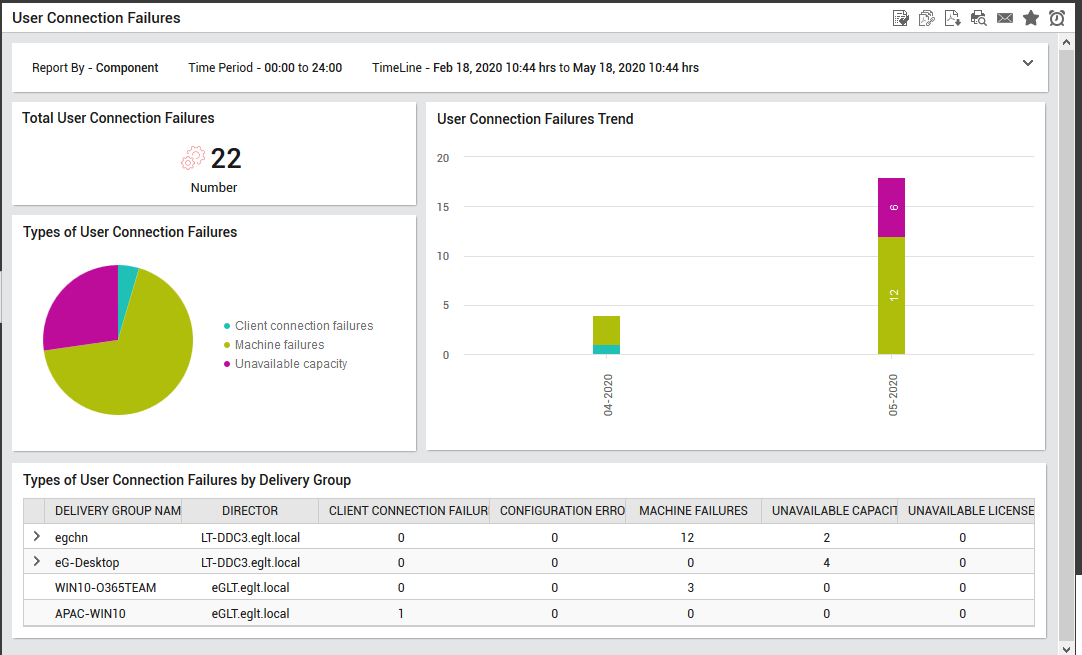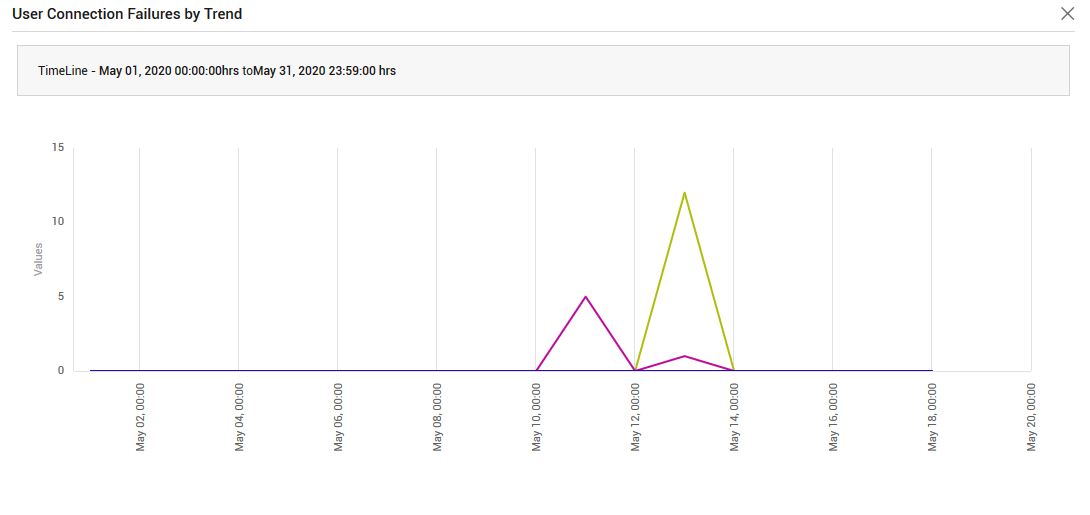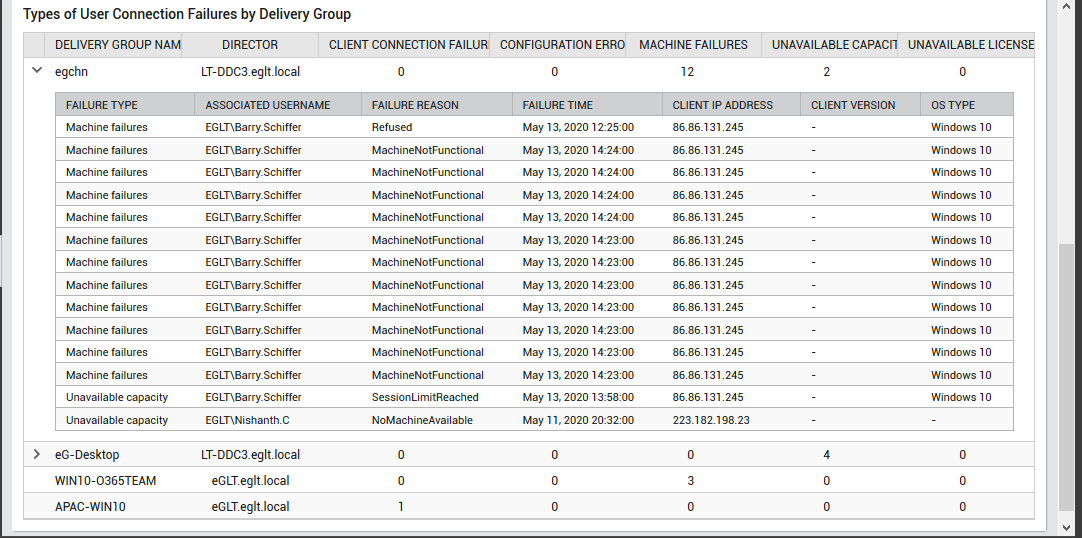User Connection Failures Report
Connection failures to a desktop/application impact user experience with Citrix. Administrators should promptly identify such failures and rectify them at the earliest, so that Citrix users can be assured of a top-notch experience! For this purpose, administrators should look back at the connection failures that have occurred in the past and identify the common causes for such failures. The User Connection Failures report helps with this! This report enables administrators to historically analyze connection failures and accurately identify what has most often caused connections to fail – client-side issues? machine failures? configuration errors? exhaustion of delivery group capacity? absence of a license? Additionally, the report also enables a detailed analysis of connection failures by delivery group, thus pointing administrators to those delivery groups with the highest number of connection failures, along with the reasons for the same. The report also provides useful information related to each connection attempt that failed per delivery group – this includes the user who initiated the connection, the IP and operating system of the client from which the connection was initiated, and the reason for the failure. This way, the report enables quick and accurate diagnosis of the root-cause of connection failures, sheds light on the delivery groups and users impacted by the same, and thus hastens an effective and appropriate resolution.
To generate this report, do the following:
- Follow the menu sequence: REPORTS BY FUNCTION -> Domain-specific Reports -> Virtual Applications / Desktops (Citrix XenApp / XenDesktop) -> Citrix Connection Brokering -> User Connection Failures.
-
Figure 1 then appears. In Figure 1, select a criteria for analysis from the Analyze By list box.

Figure 1 : Specifying the criteria for generating the User Connection Failures report
-
Using this report, you can analyze the user connection failures noticed on one/more managed components, or those that are part of a zone, service or segment. The options provided by the Analyze By list box are discussed hereunder:
- Component: Select this option to choose the component(s) from across all the managed components in the environment.
- Zone: To generate a report for one/more components that are included in a zone, pick the Zone option. A Zone drop-down list will then appear, from which you would have to select the zone to which the components of interest to you belong. A Sub zone flag also appears. Indicate whether the components present within the sub-zones of the chosen zone are also to be to be considered for report generation, by setting the Sub zone flag to Yes.
- Segment: If you want to generate a report for one/more chosen components that belong to a segment, select the Segment option from Analyze By list box, and then pick the Segment from the drop-down list that appears.
- Service: If you want to generate a report for one/more components involved in the delivery of a service, select the Service option from Analyze By, and then pick the required Service from the drop-down list that appears.
- By default, Desktop is chosen from the Machine Type list indicating that this report will be generated for the Desktop OS machines alone by default. If you wish to generate this report for Server OS machines, then choose Server from this list. Choosing the All option will generate this report for both Desktop and Server OS machines.
- The delivery groups containing the machines of the chosen machine type will be listed in the Delivery Groups list. By default, All option is chosen from this list. If you wish to generate this report for a chosen delivery group, then you can choose that particular delivery group alone and proceed with other specifications needed for generating the report.
- Choose a Component Type for which the report is to be generated.
- The Components list will now be populated with all the components that are managed in your environment for the chosen component type. If the Components list consists of too many components, then viewing all the components and selecting the ones you need for report generation could require endless scrolling. To avoid this, you can click the
 button next to the Components list. A Components pop up window will then appear using which you can view almost all the components in a single interface and Select the ones to be included in this report.
button next to the Components list. A Components pop up window will then appear using which you can view almost all the components in a single interface and Select the ones to be included in this report. -
Then, specify the Timeline for generating this report. You can either provide a fixed time line such as 1 hour, 2 days, etc., or select the Any option from the list to provide a From and To date/time for report generation.
Note:
For every user registered with the eG Enterprise system, the administrator can indicate the maximum timeline for which that user can generate a report. Once the maximum timeline is set for a user, then, whenever that user logs into eG Reporter and attempts to generate a report, the Timeline list box in the report page will display options according to the maximum timeline setting of that user. For instance, if a user can generate a report for a maximum period of 3 days only, then 3 days will be the highest option displayed in the Timeline list - i.e., 3 days will be the last option in the fixed Timeline list. Similarly, if the user chooses the Any option from the Timeline list and proceeds to provide a start date and end date for report generation using the From and To specifications, eG Enterprise will first check if the user's Timeline specification conforms to his/her maximum timeline setting. If not, report generation will fail. For instance, for a user who is allowed to generate reports spanning over a maximum period of 3 days only, the difference between the From and To dates should never be over 3 days. If it is, then, upon clicking the Run Report button a message box will appear, prompting the user to change the From and To specification.
-
In addition to the settings discussed above, this report comes with a set of default specifications. These settings are hidden by default. If you do not want to disturb these default settings, then you can proceed to generate the report by clicking the Run Report button soon after you pick one/more components for report generation. However, if you want to view and then alter these settings (if required), click on the
 icon. The default settings will then appear in the MORE OPTIONS drop down window (See Figure 2). The steps below discuss each of these settings and how they can be customized.
icon. The default settings will then appear in the MORE OPTIONS drop down window (See Figure 2). The steps below discuss each of these settings and how they can be customized.
-
If the timeline specified for the report needs to exclude the data collected during the Weekends, then set Exclude weekends to Yes. If not, select No.
Note:
By default, the weekend constitutes Saturday and Sunday. To override this default setting, do the following:
- Edit the eg_report.ini file in the <EG_INSTALL_DIR>\manager\config directory.
- In the [EXCLUDE_WEEKEND] section of the file, the Days parameter is set to Saturday,Sunday by default. You can modify this by setting the Days parameter to a comma-separated list of other days of the week - say Friday,Saturday.
- Save the file after making the required changes.
-
Next, indicate the report Time period.
Note:
By default, the Time period is set to 24 hours. Accordingly, the From and To parameters in the [timeframe] section of the eg_report.ini file (in the <eg_install_dir>\manager\config directory) are set to 00:00 and 24:00 respectively. If need be, you can override this default setting by configuring a different timeframe against the From and/or To parameters.
-
In large environments, reports generated using months of data can take a long time to complete. Administrators now have the option of generating reports on-line or in the background. When a report is scheduled for background generation, administrators can proceed with their other monitoring, diagnosis, and reporting tasks, while the eG manager is processing the report. This saves the administrator valuable time. To schedule background processing of a report, you can either select the Background Save - PDF option from the Report Generation list. To process reports in the foreground, select the Foreground Generation - HTML option from this list.
Note:
- The Report Generation list will appear only if the EnableBackgroundReport flag in the [BACKGROUND_PROCESS] section of the eg_report.ini file (in the <EG_INSTALL_DIR>\manager\config directory) is set to Yes.
- The default selection in the Report Generation list will change according to the Timeline specified for the report. If the Timeline set is greater than or equal to the number of days specified against the MinDurationForReport parameter in the [BACKGROUND_PROCESS] section of the eg_report.ini file, then the default selection in the Report Generation list will be Background Save - PDF. On the other hand, if the Timeline set for the report is lesser than the value of the MinDurationForReport parameter, then the default selection in the Report Generation list will be Foreground. This is because, the MinDurationForReport setting governs when reports are to be processed in the background. By default, this parameter is set to 2 weeks - this indicates that by default, reports with a timeline of 2 weeks and above will be processed in the background.
- Click the Done button if any changes were made to the More Options drop down window.
- Finally, click the Run Report button to generate the report.
-
If the Report type is Foreground Generation - HTML, then Figure 3 will appear as soon as you click the Run Report button.

Figure 3 : The generated User Connection Failures Report
The sections in Figure 3 are described in detail:
- The total user connection failures that were encountered in the chosen time period;
- A pie chart revealing the types of connection failures detected in a site during the chosen time period. Hovering over a slice in the pie chart will reveal the count of connection failures that were detected for that particular type;
-
The User Connection Failure Trend section reveals a bar graph that displays the count of connection failures detected on each day during the chosen time period. Clicking on a bar will lead you to Figure 4 which displays a trend graph on how the connection failures occurred over a period of time. This will help administrators identify the exact date/time on which there were too many connection failures of a particular type were reported.

Figure 4 : The User Connection Trend graph revealing the times when the failures peaked
-
The Types of User Connection Failures by Delivery Group section reveals the name of each delivery group, the component to which the delivery group belongs to and the count of connection failures detected for each type. Further drilling down each delivery group (see Figure 5) will reveal the type of failure, the reason for failure, the user who initiated the connection, the exact time at which the failure was detected, the client IP address, the client version and the Operating system of the machine on which the user logged in.

Figure 5 : Detecting the user who frequently encountered connection failures and the reason for the same
From Figure 5, administrators can perform quick and accurate diagnosis of the root-cause of connection failures, identify the delivery groups and users impacted by the same, and thus offer an effective and appropriate resolution.
